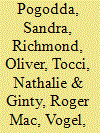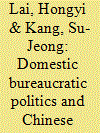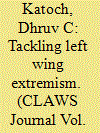|
|
|
Sort Order |
|
|
|
Items / Page
|
|
|
|
|
|
|
| Srl | Item |
| 1 |
ID:
131624


|
|
|
|
|
| Publication |
2014.
|
| Summary/Abstract |
European Union (EU) interventions in conflict countries tend to focus on governance reforms of political and economic frameworks instead of the geopolitical context or the underlying power asymmetries that fuel conflict. They follow a liberal pattern often associated with northern donors and the UN system more generally. The EU's approach diverges from prevalent governance paradigms mainly in its engagement with social, identity and socio-economic exclusion. This article examines the EU's 'peace-as-governance' model in Cyprus, Georgia, Palestine and Bosnia and Herzegovina. These cases indicate that a tense and contradictory strategic situation may arise from an insufficient redress of underlying conflict issues.
|
|
|
|
|
|
|
|
|
|
|
|
|
|
|
|
| 2 |
ID:
128275


|
|
|
|
|
| Publication |
2014.
|
| Summary/Abstract |
One of the outstanding features of China's domestic politics is the prominence of the bureaucracy in the policy-making process. Arguably, bureaucracy is the next major player in the policy-making process in China after the top leaders. In this article, the three following aspects of the role of bureaucracy in the Chinese foreign policy-making process are examined: (1) the structure of the bureaucracy, especially the main agencies of the bureaucracy involved in foreign policy making; (2) the respective responsibilities of these agencies and their roles in the process; and (3) inter-agency coordination including the resolution of conflict among them. It observes that while the Ministry of Foreign Affairs plays a key role in the process, other ministries and bureaucratic agencies have significant and even growing input in an increasing number of functional areas, such as trade, finance, economy, climate change, soft power and military affairs. In addition, coordination among these agencies has become a key in the policy-making process.
|
|
|
|
|
|
|
|
|
|
|
|
|
|
|
|
| 3 |
ID:
131457


|
|
|
|
|
| Publication |
2014.
|
| Summary/Abstract |
This research examines the role of the Lebanese Armenian diaspora (LAD) during the unstructured conflict that was the second Lebanese civil war, which extended from 1975 until 1990. This research has two aims. The normative aim is to find patterns of diasporic activity in conflict such as to support positive activities and discourage negative activities. A second is to focus on an empirical case study of the LAD in order to demonstrate that the diaspora encouraged peace-making initiatives and discouraged peace-wrecking. Importantly, the LAD as a political actor in Lebanese society played a positive role in promoting dialogue, cooperation, conflict resolution and reconciliation and had a significant impact on politics in general and conflict behaviour in particular. This study concludes that it is worth studying diaspora behaviour in conflict because a diaspora could be a powerful actor in conflict resolution and peace-making.
|
|
|
|
|
|
|
|
|
|
|
|
|
|
|
|
| 4 |
ID:
132401


|
|
|
|
|
| Publication |
2014.
|
| Summary/Abstract |
Indonesia is often regarded as the natural leader of the Association of Southeast Asian Nations (ASEAN) in light of its geographical dimensions, large population, strategic position and natural resources. The country has felt entitled to a position of leadership and has generally been recognized by the other ASEAN members as first among equals. While the de facto leadership of Indonesia has traditionally been accepted as conventional wisdom, little attention has been given to the extent to which Jakarta has actually succeeded in exercising leadership in ASEAN and how its attempt to do so has been perceived by the other Southeast Asian states. The paper explores this question by focusing on Indonesia's ability to provide international public goods in the areas of security and economics, engage in conflict management and promote institution building. It argues that the country has sought to establish a stable and autonomous security environment, to conduct conflict meditation efforts in the Cambodian conflict and the South China Sea disputes, and to develop institutional mechanisms to promote security, democracy and human rights among other issues. Still, Indonesia's leadership in ASEAN has been incomplete due to resistance from some members to its preference for an autonomous regional order and in recent years a democratic form of domestic governance. Its leadership has so far also been limited to the political and security spheres, leaving other sectors, like the economy, to others.
|
|
|
|
|
|
|
|
|
|
|
|
|
|
|
|
| 5 |
ID:
131022


|
|
|
|
|
| Publication |
2014.
|
| Summary/Abstract |
An analysis of Left Wing Extremism (LWE) related incidents show's a welcome declining trend over the last three years. The _year 2008 witnessed 1,591 incidents of Naxal violence, which rose to over 2,200 in both 2009 and 2010. Since then, there has been a dip to 1,760, 1,415 and 1,129 incidents across the country for the years 201 1, 2012 and 2013 respectively.' The fatalities due to Naxal violence have also registered a sharp decline over the last three years (see Fig 1)? The trends indicate improved capability of the state governments and their security forces to deal with attacks by Maoists, especially on police posts. However, they do not indicate any appreciable degradation in the strength of the armed Wing of the Maoist groups, most notably the People's Liberation Guerrilla Army (PLGA) of the Communist Party of India (Mam), [CPM(M)] which does not appear to have been weakened in any appreciable manner.
|
|
|
|
|
|
|
|
|
|
|
|
|
|
|
|
|
|
|
|
|